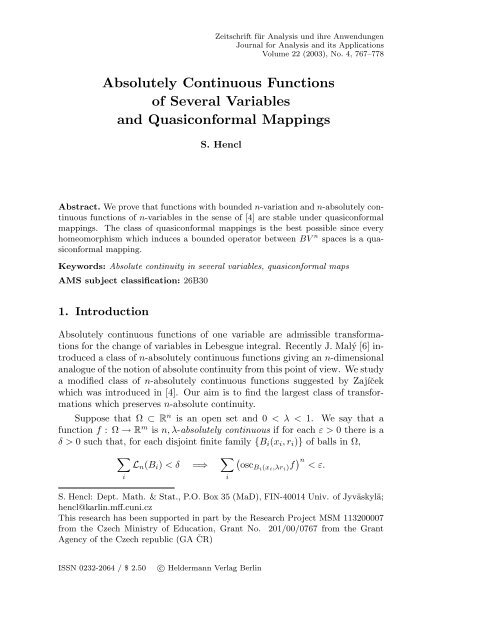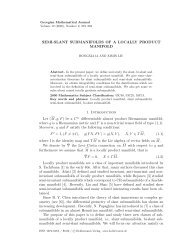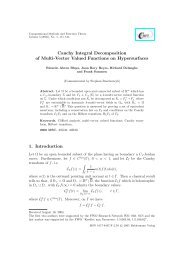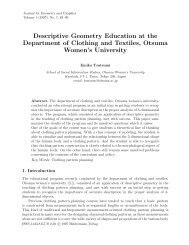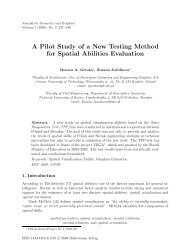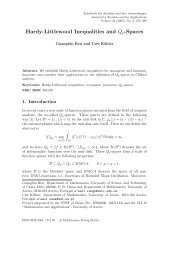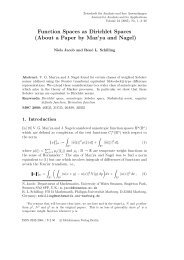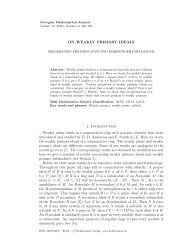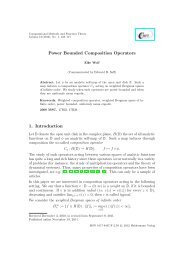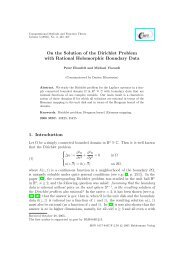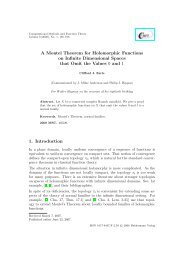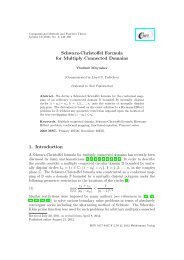Absolute continuity for functions of several variables - Heldermann ...
Absolute continuity for functions of several variables - Heldermann ...
Absolute continuity for functions of several variables - Heldermann ...
Create successful ePaper yourself
Turn your PDF publications into a flip-book with our unique Google optimized e-Paper software.
Zeitschrift für Analysis und ihre Anwendungen<br />
Journal <strong>for</strong> Analysis and its Applications<br />
Volume 22 (2003), No. 4, 767–778<br />
<strong>Absolute</strong>ly Continuous Functions<br />
<strong>of</strong> Several Variables<br />
and Quasicon<strong>for</strong>mal Mappings<br />
S. Hencl<br />
Abstract. We prove that <strong>functions</strong> with bounded n-variation and n-absolutely continuous<br />
<strong>functions</strong> <strong>of</strong> n-<strong>variables</strong> in the sense <strong>of</strong> [4] are stable under quasicon<strong>for</strong>mal<br />
mappings. The class <strong>of</strong> quasicon<strong>for</strong>mal mappings is the best possible since every<br />
homeomorphism which induces a bounded operator between BV n spaces is a quasicon<strong>for</strong>mal<br />
mapping.<br />
Keywords: <strong>Absolute</strong> <strong>continuity</strong> in <strong>several</strong> <strong>variables</strong>, quasicon<strong>for</strong>mal maps<br />
AMS subject classification: 26B30<br />
1. Introduction<br />
<strong>Absolute</strong>ly continuous <strong>functions</strong> <strong>of</strong> one variable are admissible trans<strong>for</strong>mations<br />
<strong>for</strong> the change <strong>of</strong> <strong>variables</strong> in Lebesgue integral. Recently J. Malý [6] introduced<br />
a class <strong>of</strong> n-absolutely continuous <strong>functions</strong> giving an n-dimensional<br />
analogue <strong>of</strong> the notion <strong>of</strong> absolute <strong>continuity</strong> from this point <strong>of</strong> view. We study<br />
a modified class <strong>of</strong> n-absolutely continuous <strong>functions</strong> suggested by Zajíček<br />
which was introduced in [4]. Our aim is to find the largest class <strong>of</strong> trans<strong>for</strong>mations<br />
which preserves n-absolute <strong>continuity</strong>.<br />
Suppose that Ω ⊂ R n is an open set and 0 < λ < 1. We say that a<br />
function f : Ω → R m is n, λ-absolutely continuous if <strong>for</strong> each ε > 0 there is a<br />
δ > 0 such that, <strong>for</strong> each disjoint finite family {B i (x i , r i )} <strong>of</strong> balls in Ω,<br />
∑<br />
(<br />
oscBi (x i ,λr i )f ) n<br />
< ε.<br />
i<br />
L n (B i ) < δ =⇒ ∑ i<br />
S. Hencl: Dept. Math. & Stat., P.O. Box 35 (MaD), FIN-40014 Univ. <strong>of</strong> Jyväskylä;<br />
hencl@karlin.mff.cuni.cz<br />
This research has been supported in part by the Research Project MSM 113200007<br />
from the Czech Ministry <strong>of</strong> Education, Grant No. 201/00/0767 from the Grant<br />
Agency <strong>of</strong> the Czech republic (GA ČR)<br />
ISSN 0232-2064 / $ 2.50<br />
c○ <strong>Heldermann</strong> Verlag Berlin
768 S. Hencl<br />
<strong>Absolute</strong> <strong>continuity</strong> from [6] coincides with n, 1-absolute <strong>continuity</strong>. It is<br />
proved in [4, 6] that n, λ-absolute <strong>continuity</strong> implies <strong>continuity</strong>, weak differentiability<br />
with gradient in L n , differentiability almost everywhere and a<br />
<strong>for</strong>mula on change <strong>of</strong> <strong>variables</strong>.<br />
It was shown by Csörnyei [1] that there exists a 2, 1-absolutely continuous<br />
function with respect to balls, which is not a function <strong>of</strong> this type with respect<br />
to cubes, where the concept in question is defined by an obvious modification<br />
to the definition given above. On the contrary, n, λ-absolute <strong>continuity</strong> does<br />
not depend on the shape <strong>of</strong> the ”ball” in the definition <strong>for</strong> 0 < λ < 1 (see [4]<br />
<strong>for</strong> details). The class <strong>of</strong> absolutely continuous <strong>functions</strong> also does not depend<br />
on the precise value <strong>of</strong> λ if 0 < λ < 1 (see Theorem 3.5 below). From this<br />
point <strong>of</strong> view it is more natural to work with the new definition (i.e. with<br />
0 < λ < 1).<br />
Given a measurable set A ⊂ R n and a function f : A → R m , we define<br />
the n, λ-variation <strong>of</strong> f on A by<br />
V n λ (f, A) = sup<br />
{ ∑<br />
i<br />
(<br />
oscB(xi ,λr i )f ) n<br />
:<br />
{B(x i , r i )} is a disjoint<br />
finite family <strong>of</strong> balls in A<br />
We denote by BVλ n(Ω) the class <strong>of</strong> all <strong>functions</strong> such that V λ n (f, Ω) < ∞,<br />
define the space ACλ n (Ω) as the family <strong>of</strong> all n, λ-absolutely continuous <strong>functions</strong><br />
in BVλ n(Ω) and write ACn λ,loc<br />
<strong>for</strong> the class <strong>of</strong> all <strong>functions</strong> f such that<br />
f ∈ ACλ n (K) <strong>for</strong> every compact set K ⊂ Ω.<br />
We prove in Section 3 that if Ω ⊂ R n (n ≥ 2) is an open set, 0 < λ < 1<br />
and F : Ω → R n is a quasicon<strong>for</strong>mal mapping, then<br />
(i) f ∈ BVλ n(Ω) ⇐⇒ f ◦ F −1 ∈ BVλ n (F (Ω))<br />
(ii) f ∈ ACλ n(Ω) ⇐⇒ f ◦ F −1 ∈ ACλ n (F (Ω)).<br />
This extends the result from [4] where F was a bi-Lipschitz mapping. Note<br />
that the class AC1<br />
n is not stable even under bi-Lipschitz mappings (see [5] <strong>for</strong><br />
details).<br />
Using ideas from [2] we prove the following result in Section 4:<br />
Let 0 < λ ≤ 1 and n ≥ 2. If a homeomorphism F : Ω → R n induces a<br />
bounded operator from BVλ n(F (Ω)) to BV λ n (Ω), then F is a quasicon<strong>for</strong>mal<br />
mapping.<br />
It follows that the results in Section 3 are sharp.<br />
}<br />
.
2. Preliminaries<br />
<strong>Absolute</strong> Continuity and Quasicon<strong>for</strong>mal Mappings 769<br />
Throughout the paper we consider an open set Ω ⊂ R n (n > 1). We denote<br />
- by L n (A) or |A| the n-dimensional Lebesgue measure <strong>of</strong> a set A ⊂ R n<br />
- by λ a real number 0 < λ < 1<br />
- by B(x, r) the n-dimensional Euclidean open ball with center x and diameter<br />
r (throughout the paper we use the letter B <strong>for</strong> balls only)<br />
- by B(x, r) the corresponding closed ball<br />
- λB = B(x, λr) <strong>for</strong> a given ball B = B(x, r)<br />
- by S(x, r) = {y ∈ R n : |x − y| = r} a sphere<br />
- by osc A f the oscillation <strong>of</strong> f : Ω → R m over the set A ⊂ Ω, which is the<br />
diameter <strong>of</strong> f(A)<br />
- by F ′ (x) <strong>for</strong> a mapping F : Ω → R n the Jacobi matrix <strong>of</strong> all partial<br />
derivatives <strong>of</strong> F at x<br />
- by ∇F the weak (distributional) derivative<br />
- by J F (x) the determinant <strong>of</strong> the Jacobi matrix <strong>of</strong> F (x)<br />
- by W 1,p (Ω) and W 1,p<br />
loc<br />
(Ω) the Sobolev spaces.<br />
A mapping F : Ω → R n is called a homeomorphism if there exists its inverse<br />
F −1 and both F and F −1 are continuous. We write f ◦ F or F ⋆ f <strong>for</strong> the<br />
composition <strong>of</strong> the <strong>functions</strong> F : Ω → R n and f : F (Ω) → R m ; that is (f ◦<br />
F )(x) = (F ⋆ f)(x) = f(F (x)) <strong>for</strong> every x ∈ Ω. We say that a homeomorphism<br />
F : Ω → R n induces a bounded operator F ⋆ : BVλ n(F (Ω)) → BV λ n (Ω) if<br />
there is a constant C > 0 such that Vλ n(F ⋆ f, Ω) ≤ C Vλ n (f, F (Ω)) <strong>for</strong> every<br />
f ∈ BVλ n (F (Ω)).<br />
We use the convention that C denotes a generic positive constant which<br />
may change from expression to expression.<br />
3. Stability <strong>of</strong> AC n λ<br />
under quasicon<strong>for</strong>mal mappings<br />
In this section we will prove that classes <strong>of</strong> <strong>functions</strong> ACλ n and BV λ<br />
n<br />
with respect to quasicon<strong>for</strong>mal change <strong>of</strong> <strong>variables</strong>.<br />
are stable<br />
Definition 3.1. Let 1 ≤ K < ∞. A mapping F : Ω → R n is called<br />
K-quasicon<strong>for</strong>mal, if it satisfies the following properties:<br />
(i) F is a homeomorphism<br />
(ii) F ∈ W 1,n<br />
loc (Ω, Rn )<br />
(iii) |∇F (x)| n ≤ K|J F (x)| <strong>for</strong> almost every x ∈ Ω.<br />
We say that a mapping F is quasicon<strong>for</strong>mal, if there is K < ∞ such that f is<br />
K-quasicon<strong>for</strong>mal.<br />
For the history and basic properties <strong>of</strong> quasicon<strong>for</strong>mal mappings we refer<br />
the reader to [8].
770 S. Hencl<br />
Definition 3.2. A function F : Ω → R n is η-quasisymmetric if there is<br />
a homeomorphism η : [0, ∞) → [0, ∞) such that, <strong>for</strong> every a, b, x ∈ Ω and<br />
ρ ≥ 0,<br />
|a − x| ≤ ρ|b − x| =⇒ |F (a) − F (x)| ≤ η(ρ)|F (b) − F (x)|.<br />
The following theorem [6: Theorem 2.4] states that quasicon<strong>for</strong>mal mappings<br />
are locally quasisymmetric.<br />
Theorem 3.3. Suppose n ≥ 2, F : Ω → R n is a K-quasicon<strong>for</strong>mal<br />
mapping and x 0 ∈ Ω, α > 1, r > 0 and B(x 0 , αr) ⊂ Ω. Then F | B(x0 ,r) is<br />
η-quasisymmetric where η depends only on n, K and α.<br />
Using this theorem <strong>for</strong> α = 2 and a quasicon<strong>for</strong>mal mapping F : Ω → R n ,<br />
there is 0 < ρ 0 < 1 such that, <strong>for</strong> a fixed x ∈ Ω and r < ρ 0<br />
2<br />
dist(x, ∂Ω),<br />
sup |F (x) − F (a)| ≤ 1 inf |F (x) − F (b)|. (3.1)<br />
{a:|x−a|≤r}<br />
4 {b:|x−b|= r<br />
ρ<br />
} 0<br />
Lemma 3.4. Let 0 < λ ≤ 1, f ∈ BVλ n(Ω) and f ∈ ACn λ,loc<br />
(Ω). Then<br />
f ∈ ACλ n(Ω).<br />
Pro<strong>of</strong>. Fix ε > 0. It is not difficult to see from the definition <strong>of</strong> n, λ-<br />
variation that we can find a finite collection <strong>of</strong> pairwise disjoint balls B(x i , r i )<br />
such that B(x i , r i ) ⊂ Ω and<br />
∑ (<br />
oscB(xi ,λr i )f ) n<br />
> V<br />
n<br />
λ (f, Ω) − ε.<br />
i<br />
Since Ω is open and B(x i , r i ) ⊂ Ω, we can find k ∈ N such that <strong>for</strong><br />
Ω k =<br />
{<br />
x ∈ Ω : |x| < k and dist (x, ∂Ω) > 1 }<br />
k<br />
(3.2)<br />
we have B(x i , r i ) ⊂ Ω k <strong>for</strong> each i and there<strong>for</strong>e Vλ n(f, Ω k) > Vλ n (f, Ω) − ε.<br />
From this fact and Vλ n(Ω k) + Vλ n(Ω \ Ω k) ≤ Vλ n(Ω) we obtain V λ n(Ω \ Ω k) < ε.<br />
For a given ε we can find δ 1 from the definition <strong>of</strong> AC n λ (Ω k+1) <strong>for</strong> f. Put<br />
( (<br />
1<br />
))}<br />
δ = min<br />
{δ 1 , L n B 0,<br />
. (3.3)<br />
2k(k + 1)<br />
Fix pairwise disjoint balls B 1 , . . . , B l in Ω such that ∑ l<br />
i=1 L n(B i ) < δ. From<br />
(3.3) we obtain diam(B i ) < 1 k − 1<br />
k+1<br />
(i ∈ {1, . . . , l}). Thus (3.2) gives that
<strong>Absolute</strong> Continuity and Quasicon<strong>for</strong>mal Mappings 771<br />
either B i ⊂ Ω k+1 or B i ⊂ Ω \ Ω k <strong>for</strong> every i. Hence we obtain from the<br />
definition <strong>of</strong> δ 1 and k that<br />
∑<br />
∑<br />
∑<br />
osc n λB i<br />
f ≤ osc n λB i<br />
f + osc n λB i<br />
f<br />
i<br />
i:B i ⊂Ω k+1 i:B i ⊂Ω\Ω k ∑<br />
≤ osc n λB i<br />
f + Vλ n (Ω \ Ω k )<br />
i:B i ⊂Ω k+1<br />
and the pro<strong>of</strong> is finished<br />
≤ ε + ε<br />
= 2ε<br />
The following theorem [3: Theorem 3.1] gives us the opportunity to use<br />
any λ ∈ (0, 1) in the definition <strong>of</strong> the classes ACλ n and BV λ n . We will use this<br />
fact in the pro<strong>of</strong> <strong>of</strong> Theorem 3.6.<br />
Theorem 3.5. Let 0 < λ 1 < λ 2 < 1 and f : Ω → R m . Then BV n λ 1<br />
(Ω) =<br />
BV n λ 2<br />
(Ω) and AC n λ 1<br />
(Ω) = AC n λ 2<br />
(Ω).<br />
Now we can prove the main result <strong>of</strong> this section.<br />
Theorem 3.6. Let n ≥ 2 and 0 < λ < 1. Suppose that the mapping<br />
F : Ω → R n is K-quasicon<strong>for</strong>mal and f : Ω → R. Then:<br />
(i) f ◦ F −1 ∈ BV n λ (F (Ω)) =⇒ f ∈ BV n λ (Ω)<br />
(ii) f ◦ F −1 ∈ AC n λ (F (Ω)) =⇒ f ∈ ACn λ (Ω).<br />
Pro<strong>of</strong>. Let us first suppose that f ◦ F −1 ∈ BVλ n (F (Ω)). Thanks to<br />
Theorem 3.5 we can suppose that λ = 1 2 . We will prove that f ∈ BV n ρ 02 (Ω).<br />
Recall that the constant 0 < ρ 0 < 1 comes from (3.1).<br />
Suppose that B i = B(x i , r i ) ⊂ Ω are pairwise disjoint balls. Clearly,<br />
( (<br />
F B x i , ρ ))<br />
)<br />
0<br />
2 r i ⊂ B<br />
(F (x i ), osc B(xi , ρ 0<br />
2<br />
r i ) F . (3.4)<br />
Thanks to (3.1), <strong>for</strong> r = ρ 0<br />
2<br />
r i and x = x i we have<br />
)<br />
B<br />
(F (x i ), 2osc B(xi , ρ 0<br />
2<br />
r i ) F<br />
(<br />
)<br />
⊂ B F (x i ), 4 sup |F (x i ) − F (a)|<br />
(<br />
⊂ B F (x i ),<br />
( (<br />
⊂ F B x i , 1 2 r i<br />
{a:|x i −a|≤ ρ 0<br />
2<br />
r i }<br />
inf<br />
{b:|x i −b|= 1 ρ 02<br />
ρ<br />
r i }<br />
0<br />
))<br />
.<br />
)<br />
|F (x i ) − F (b)|<br />
(3.5)
772 S. Hencl<br />
Hence the balls ˜B i = B ( F (x i ), 2osc B(xi , ρ 0<br />
2<br />
r i ) F ) are pairwise disjoint in F (Ω).<br />
Thus (3.4) gives us<br />
∑<br />
osc n B(x i , ρ 0<br />
2<br />
r i ) f = ∑<br />
i<br />
i<br />
≤ ∑ i<br />
osc n F (B(x i , ρ 0<br />
2<br />
r i )) f ◦ F −1<br />
osc n −1<br />
B(F (x i ),osc B(xi , ρ 0 F<br />
r 2 i<br />
)f ◦ F<br />
)<br />
= ∑ osc n 1<br />
f ◦ F −1<br />
2 ˜B i<br />
i<br />
≤ V n (<br />
1 f ◦ F −1 , F (Ω) ) .<br />
2<br />
(3.6)<br />
It follows that V n ρ 02 (f, Ω) ≤ V n 1 (f ◦ F −1 , F (Ω)) < ∞.<br />
2<br />
Now let us suppose that f ◦ F −1 ∈ ACλ n (F (Ω)). As be<strong>for</strong>e we can assume<br />
that λ = 1 2 . From the conclusions above we obtain f ∈ BV n ρ 02 (Ω). Thanks to<br />
Lemma 3.4 and Theorem 3.5 it is enough to prove that f ∈ AC n ρ 02<br />
,loc (Ω).<br />
AC n 1<br />
2<br />
Fix ε > 0 and Ω ′ ⊂ Ω such that Ω ′ ⊂ Ω. Choose δ 1 from the definition <strong>of</strong><br />
(Ω) <strong>for</strong> function f ◦ F −1 . By [4: Theorem 4.3], quasicon<strong>for</strong>mal mappings<br />
are locally absolutely continuous and there<strong>for</strong>e F ∈ AC n λ (Ω′ ). Hence <strong>for</strong> a<br />
given ε 1 = δ 1<br />
2 n we can choose δ 2 from the definition <strong>of</strong> AC n ρ 02 (Ω ′ ) <strong>for</strong> the<br />
function F .<br />
∑<br />
Suppose that the balls B i = B(x i , r i ) ⊂ Ω ′ are pairwise disjoint and<br />
i L n(B i ) < δ 2 . As be<strong>for</strong>e we obtain (3.4) and (3.5). There<strong>for</strong>e the balls<br />
)<br />
˜B i = B<br />
(F (x i ), 2osc B(xi , ρ 0<br />
2<br />
r i) F<br />
are pairwise disjoint in F (Ω ′ ). Further, ∑ i L n(B i ) < δ 2 and the definition <strong>of</strong><br />
δ 2 give us<br />
∑<br />
L n ( ˜B i ) = 2 ∑ n i<br />
i<br />
osc n B(x i , ρ 0<br />
2<br />
r i) F ≤ 2n ε 1 = 2 n δ 1<br />
2 n = δ 1.<br />
Analogously to (3.6) we obtain from the definition <strong>of</strong> δ 1 that<br />
and the pro<strong>of</strong> is finished<br />
∑<br />
osc n B(x i , ρ 0<br />
2<br />
r i ) f ≤ ∑<br />
i<br />
i<br />
osc n 1<br />
f ◦ F −1 < ε<br />
2 ˜B i<br />
The inverse mapping to a quasicon<strong>for</strong>mal mapping is also quasicon<strong>for</strong>mal<br />
[7: Corollary 13.3] and hence we have the following
<strong>Absolute</strong> Continuity and Quasicon<strong>for</strong>mal Mappings 773<br />
Corollary 3.7. Let 0 < λ < 1, n ≥ 2 and let f : Ω → R m . Suppose that<br />
F : Ω → R n is a quasicon<strong>for</strong>mal mapping. Then:<br />
(i) f ∈ BVλ n(Ω) ⇐⇒ f ◦ F −1 ∈ BVλ n (F (Ω))<br />
(ii) f ∈ ACλ n(Ω) ⇐⇒ f ◦ F −1 ∈ ACλ n (F (Ω)).<br />
The following elementary example shows that the assumption f ∈ BVλ<br />
n<br />
from the definition <strong>of</strong> the class ACλ n is important in Theorem 3.6.<br />
Example 3.8. Let 0 < λ < 1. There exists a domain Ω ⊂ R 2 and a<br />
1-quasicon<strong>for</strong>mal mapping F : Ω → R 2 such that f ◦ F −1 is 2, λ-absolutely<br />
continuous on F (Ω) but f is not 2, λ-absolutely continuous on Ω.<br />
Indeed, set Ω = { [x, y] : x > 0 } and F (x, y) = [<br />
]<br />
x −y<br />
x 2 +y<br />
, 2 x 2 +y . In other<br />
2<br />
words, <strong>for</strong> z ∈ C we define F (z) = 1 z (thus also F −1 (z) = 1 z<br />
). It is well known<br />
that the mapping 1 z<br />
is con<strong>for</strong>mal and hence also 1-quasicon<strong>for</strong>mal [7: Theorem<br />
8.1]. Plainly, F (Ω) = {[x, y] : x > 0}. Put<br />
˜f(x) =<br />
∞∑<br />
max { 0, 1 − dist(x, [2k, 0]) } .<br />
k=1<br />
Clearly, ˜f is a Lipschitz function with Lipschitz constant 1 on F (Ω) and hence<br />
also 2, λ-absolutely continuous.<br />
Set f = ˜f ◦ F (hence ˜f = f ◦ F −1 ) and B k = B([2k, 0], 1). Properties <strong>of</strong><br />
inversion and easy computation gives us<br />
([ 1<br />
˜B k := F −1 2k+1<br />
(B k ) = B<br />
+ ]<br />
1<br />
1<br />
2k−1 2k−1<br />
, 0 ,<br />
− )<br />
1<br />
2k+1<br />
2<br />
2<br />
<strong>for</strong> every k ∈ N. From osc˜Bk<br />
f ≥ 1 and diam ˜B k → 0 we obtain that f is not<br />
2, λ-absolutely continuous.<br />
It is not difficult to prove that the condition L n (Ω) < ∞ guarantees that<br />
any n, λ-absolutely continuous function f on Ω satisfies f ∈ BVλ n (Ω). Hence<br />
such an example can exist only if L n (F (Ω)) = ∞ in view <strong>of</strong> Theorem 3.6.<br />
4. Continuous homeomorphisms F : BV n λ → BV n λ<br />
In this section we will use ideas <strong>of</strong> Gold’stein, Gurov and Romanov [2]. They<br />
proved that a homeomorphism F : Ω → R n which induces a bounded operator<br />
from W 1,n (F (Ω)) to W 1,n (Ω) is a quasicon<strong>for</strong>mal mapping (see [2] <strong>for</strong> details<br />
and [3] <strong>for</strong> the history <strong>of</strong> similar problems).<br />
Let us denote F v(x) ′ |F (B(x,r))|<br />
= lim r→0 |B(x,r)|<br />
. We shall need the following<br />
connection between F v ′ and the Jacobian <strong>of</strong> F [7: Theorems 24.2 and 24.4].
774 S. Hencl<br />
Theorem 4.1. Let F : Ω → R n be a homeomorphism. Then:<br />
(i) F ′ v < ∞ almost everywhere.<br />
(ii) F ′ v is a measurable function.<br />
(iii) For each measurable set A ⊂ Ω, |F (A)| ≥ ∫ A F ′ v(x) dx.<br />
(iv) If F is differentiable at x and J F (x) is the Jacobi matrix <strong>of</strong> F at x,<br />
then F ′ v = |J F (x)|.<br />
Lemma 4.2. If a homeomorphism F : Ω → R n induces the bounded operator<br />
F ⋆ : BVλ n(F (Ω)) → BV λ n (Ω), then F is differentiable almost everywhere<br />
on Ω.<br />
Pro<strong>of</strong>. Fix R > 0. The mapping F is a homeomorphism and there<strong>for</strong>e<br />
the set<br />
A R = { x ∈ Ω : F (x) ∈ B(0, R) } = F −1 (B(0, R))<br />
is open. Fix 1 ≤ i ≤ n. Plainly, there is a Lipschitz function f : F (Ω) → R<br />
such that<br />
{<br />
xi <strong>for</strong> x ∈ F (Ω), |x| < R<br />
f(x) =<br />
0 <strong>for</strong> x ∈ F (Ω), |x| > R + 1.<br />
Hence f ∈ BVλ n(F (Ω)) implies F ⋆ f = f ◦ F ∈ BVλ n (Ω). If |F (x)| < R, then<br />
f ◦ F = F i (x). Thus F i (x) ∈ BVλ n(A R). Functions from BVλ n (A) are differentiable<br />
almost everywhere on A <strong>for</strong> every open set A (see [6: Theorem 3.3] and<br />
[4: Theorem 3.4] <strong>for</strong> details) and hence F i is differentiable almost everywhere<br />
on A R . Since A R → Ω as R → ∞ we obtain that F i is differentiable almost<br />
everywhere on Ω<br />
In the pro<strong>of</strong> <strong>of</strong> Theorem 4.4 below we will need the following elementary<br />
lemma [2: Lemma 3.5]:<br />
Lemma 4.3. Let F : Ω → R n be a continuous mapping and G ⊂ R k .<br />
Suppose that {K y } y∈G is a family <strong>of</strong> pairwise disjoint compact sets such that<br />
K y ⊂ F (Ω). Then L n (F −1 (K y )) = 0 <strong>for</strong> all y ∈ G except possibly a countable<br />
subset <strong>of</strong> G.<br />
Theorem 4.4. Let 0 < λ ≤ 1 and n ≥ 2. If a homeomorphism F :<br />
Ω → R n induces the bounded operator F ⋆ : BVλ n(F (Ω)) → BV λ n (Ω), then<br />
F ∈ W 1,n<br />
loc<br />
(Ω) and there is a number K such that<br />
|∇F i | n ≤ KF ′ v(x)<br />
<strong>for</strong> almost all x ∈ Ω and <strong>for</strong> all i = 1, 2, . . . , n.<br />
Pro<strong>of</strong>. In this pro<strong>of</strong> we will follow the ideas from [2: Theorem 3.6]. By<br />
Theorem 4.1, F ′ v(x) < ∞ a.e. Fix ε > 0 and a point x 0 ∈ Ω such that
<strong>Absolute</strong> Continuity and Quasicon<strong>for</strong>mal Mappings 775<br />
F ′ v(x 0 ) < ∞. There is r 0 such that <strong>for</strong> all r ∈ (0, r 0 ) we have<br />
|F (B(x 0 , 2r))| ≤ (F ′ v(x 0 ) + ε)|B(x 0 , 2r)|<br />
= (F ′ v(x 0 ) + ε)2 n |B(x 0 , r)|.<br />
(4.1)<br />
Set M = (F v(x ′ 0 ) + ε)2 n . Let us call a cube Q h-regular if all its edges are<br />
parallel to the coordinate axes, the length <strong>of</strong> the edge is h and every vertex has<br />
the <strong>for</strong>m [k 1 h, . . . , k n h] where k 1 , . . . , k n are integers. Fix r < r 0 and choose<br />
h > 0 such that<br />
h < 1 (<br />
)<br />
2 √ n dist F (S(x 0 , 2r)), F (S(x 0 , r)) .<br />
Let A be the union <strong>of</strong> all h-regular cubes Q such that Q ∩ F (B(x 0 , r)) ≠ ∅. It<br />
is evident that<br />
F (B(x 0 , r)) ⊂ A ⊂ F (B(x 0 , 2r)).<br />
Fix j ∈ {1, . . . , n} and let us focus on the j-th coordinate. Denote the hyperplanes<br />
x j = th by L t . The hyperplanes L m (m an integer) divide R n into<br />
layers<br />
Z m = { x ∈ R n : mh < x j < (m + 1)h } .<br />
Put A m = Z m ∩ A.<br />
For every A m we construct three <strong>functions</strong><br />
Here P j : R n → R n−1<br />
j<br />
the <strong>functions</strong><br />
ψ m,1 = x j − mh<br />
ψ m,2 = (m + 1)h − x j<br />
ψ m,3 = h 2 − dist( P j (x), P j (A m ) ) .<br />
is the orthogonal projection <strong>of</strong> R n onto R n−1<br />
j . Consider<br />
ψ m = max { 0, min{ψ m,1 , ψ m,2 , ψ m,3 } } and ψ = ∑ m<br />
ψ m .<br />
Put<br />
E = { x ∈ G : ψ(x) is not differentiable at x } .<br />
It follows from the definition <strong>of</strong> ψ that:<br />
(1) supp(ψ) ⊂ F (B(x 0 , 2r))<br />
(2) ψ is Lipschitz with constant 1<br />
(3) ψ ∈ BVλ n (F (Ω))<br />
(4) ψ is differentiable almost everywhere
776 S. Hencl<br />
(5) ψ(x) = ±x j + const in all components <strong>of</strong> the set F (B(x 0 , r)) \ E.<br />
The set E ∩ F (B(x 0 , r)) belongs to a finite union <strong>of</strong> hyperplanes L t1 , . . . , L ts<br />
where 2t i is an integer. By Lemma 4.3, <strong>for</strong> almost all small translations τ y<br />
parallel to the axis x j we have<br />
( (<br />
∣ F −1 τ y<br />
∞<br />
⋃<br />
i=−∞<br />
L i<br />
2<br />
)<br />
∩ F (B(x 0 , r)))∣ ∣∣∣∣<br />
= 0.<br />
Thus we can assume without loss <strong>of</strong> generality that<br />
∣ F<br />
−1 ( E ∩ F (B(x 0 , r)) )∣ ∣ = 0. (4.2)<br />
Otherwise it is possible to change the j-th coordinate <strong>of</strong> the point [0, . . . , 0]<br />
at the beginning <strong>of</strong> the construction <strong>of</strong> ψ.<br />
By the assumption <strong>of</strong> the theorem, F ⋆ ψ = ψ◦F ∈ BVλ n (Ω). It follows from<br />
(5) and (4.2) that (ψ ◦ F )(x) = ±F j (x) + const <strong>for</strong> almost all x ∈ B(x 0 , r). It<br />
is easy to see from the pro<strong>of</strong> <strong>of</strong> [5: Theorem 3.2] that BVλ n (Ω) is continuously<br />
embedded into W 1,n (Ω). These two facts give us<br />
∫<br />
B(x 0 ,r)<br />
Since F ⋆ is continuous we have<br />
∫<br />
|∇(F j (x))| n dx ≤<br />
Ω<br />
|∇(ψ ◦ F )| n dx<br />
≤ CV n λ (ψ ◦ F, Ω)<br />
= CV n λ (F ⋆ (ψ), Ω).<br />
(4.3)<br />
V n λ (F ⋆ (ψ), Ω) ≤ CV n λ (ψ, Ω). (4.4)<br />
The function ψ is Lipschitz with constant 1 and hence<br />
osc n B(x,s) ψ ≤ (2s)n = C|B(x, s)| (4.5)<br />
<strong>for</strong> each x and every s. Thanks to (4.5), the <strong>continuity</strong> <strong>of</strong> ψ and supp(ψ) ⊂<br />
F (B(x 0 , 2r)) we have<br />
V n λ (ψ, Ω) ≤ C|F (B(x 0 , 2r))|. (4.6)<br />
From (4.3), (4.4) and (4.6) it follows that<br />
∫<br />
B(x 0 ,r)<br />
|∇(F j (x))| n dx ≤ C|F (B(x 0 , 2r))|.
By (4.1),<br />
Hence<br />
∫<br />
lim sup<br />
r→0<br />
<strong>Absolute</strong> Continuity and Quasicon<strong>for</strong>mal Mappings 777<br />
B(x 0 ,r)<br />
|∇(F j (x))| n dx ≤ CM|B(x 0 , r)|.<br />
∫<br />
1<br />
|∇(F j (x))| n dx ≤ CM.<br />
|B(x 0 , r)| B(x 0 ,r)<br />
The Lebesgue Theorem gives us |∇F j (x 0 )| n ≤ C(F ′ v(x 0 ) + ε) <strong>for</strong> almost all<br />
x 0 ∈ Ω. Letting ε → 0 we obtain<br />
|∇F j (x 0 )| n ≤ CF ′ v(x 0 ) (4.7)<br />
<strong>for</strong> almost all x 0 ∈ Ω. For every compact set K ⊂ Ω we obtain from Theorem<br />
4.1 and (4.7) that<br />
∫<br />
K<br />
Thus F ∈ W 1,n<br />
loc (Ω)<br />
∫<br />
|∇F j (x)| n dx ≤ C<br />
K<br />
F ′ v(x) dx ≤ C|F (K)| < ∞.<br />
Thanks to Lemma 4.2 and Theorem 4.1/(iv) we obtain the following<br />
Corollary 4.5. Let 0 < λ ≤ 1 and Ω ⊂ R n (n ≥ 2). Each homeomorphism<br />
F : Ω → R n that induces a bounded operator from BVλ n (F (Ω)) to<br />
(Ω) is quasicon<strong>for</strong>mal.<br />
BV n λ<br />
Acknowledgement. The author wishes to express his thanks to Jan<br />
Malý <strong>for</strong> suggesting the problem and <strong>for</strong> many stimulating conversations.<br />
References<br />
[1] Csörnyei, M.: <strong>Absolute</strong>ly continuous <strong>functions</strong> <strong>of</strong> Rado, Reichelderfer and Malý.<br />
J. Math. Anal. Appl. 252 (2000), 147 – 166.<br />
[2] Gold’stein, V., Gurov, L. and A. Romanov: Homeomorphisms that induce<br />
monomorphisms <strong>of</strong> Sobolev spaces. Israel J. Math. 91 (1995), 31 – 60.<br />
[3] Gold’stein, V. and Yu. G. Reshetnyak: Quasicon<strong>for</strong>mal Mappings and Sobolev<br />
Spaces. Dordrecht: Kluwer Acad. Publ.<br />
[4] Hencl, S.: On the notions <strong>of</strong> absolute <strong>continuity</strong> <strong>for</strong> <strong>functions</strong> <strong>of</strong> <strong>several</strong> <strong>variables</strong>.<br />
Fund. Math. 173 (2002), 175 – 189.<br />
[5] Hencl, S. and J. Malý: <strong>Absolute</strong> <strong>continuity</strong> <strong>for</strong> <strong>functions</strong> <strong>of</strong> <strong>several</strong> <strong>variables</strong><br />
and diffeomorphisms. Central European J. Math. 4 (2003), 690 – 705.<br />
[6] Malý, J.: <strong>Absolute</strong>ly continuous <strong>functions</strong> <strong>of</strong> <strong>several</strong> <strong>variables</strong>. J. Math. Anal.<br />
Appl. 231 (1999), 492 – 508.
778 S. Hencl<br />
[7] Väisälä, J.: Quasi-symmetric embeddings in Euclidian spaces. Trans. Amer.<br />
Math. Soc. 264 (1981), 191 – 204.<br />
[8] Väisälä, J.: Lectures on n-Dimensional Quasicon<strong>for</strong>mal Mappings. Berlin -<br />
New York: Springer-Verlag 1971.<br />
Received 04.02.2003


